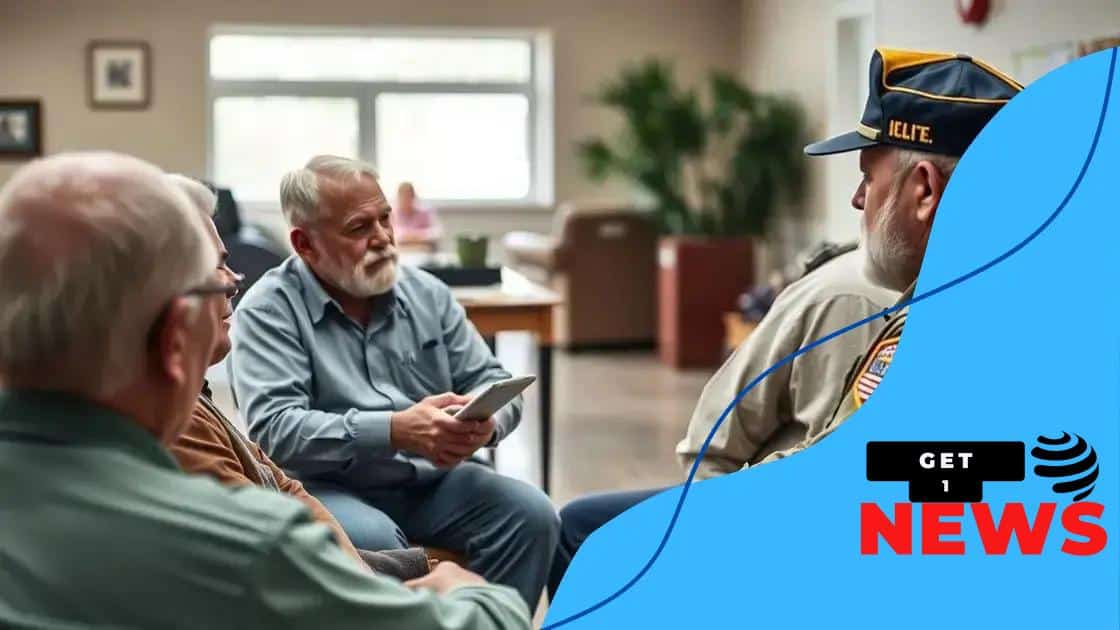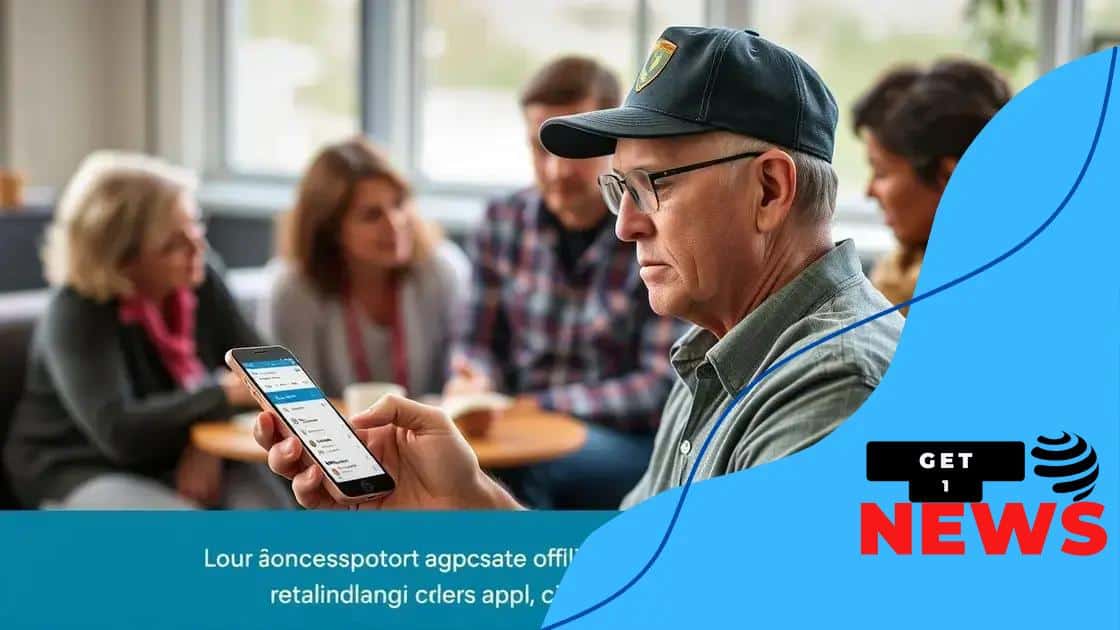Veterans’ benefit modernization: enhancing support systems

Veterans’ benefit modernization focuses on enhancing access to resources, improving mental health support, and leveraging technology to ensure veterans receive efficient and effective assistance for their unique needs.
Veterans’ benefit modernization is a crucial topic that aims to improve the services provided to our veterans. Have you ever thought about how the current systems could be enhanced for better support? Let’s explore the ongoing changes and their significance for those who served.
Understanding veterans’ benefits today
Understanding veterans’ benefits today is essential for unlocking the support our heroes deserve. With evolving policies and programs, it can be tricky to keep track of what is available. This article will help clarify these benefits, ensuring veterans can access the resources they need.
Types of Veterans’ Benefits
There are various types of benefits available for veterans. These include health care, educational assistance, and disability compensation. Each of these benefits serves a unique purpose to aid veterans in their transition to civilian life.
- Health Care: Veterans can access a wide range of medical services through the Department of Veterans Affairs (VA).
- Educational Assistance: Programs like the Post-9/11 GI Bill help veterans further their education.
- Disability Compensation: Veterans with service-connected disabilities may qualify for monthly compensation to support their living expenses.
Navigating through these benefits can be overwhelming, but understanding their purpose can simplify the process. For instance, the health care benefit covers not only hospital visits but also preventative services, mental health support, and more. Additionally, educational programs can lead to meaningful career opportunities by providing financial aid for training and college courses.
The Importance of Awareness
Awareness of veterans’ benefits can significantly impact a veteran’s quality of life. Many veterans are unaware of the full extent of the benefits available to them, leading to missed opportunities for support. By informing veterans through outreach programs and community events, we can help bridge this gap.
Moreover, family members play a crucial role in this awareness. They can guide veterans in seeking the benefits they rightfully earned. Just a simple conversation about available resources can lead to substantial improvements in a veteran’s healthcare or living situation.
Understanding veterans’ benefits today is about more than just knowing what is available; it is about ensuring that those who served are equipped with the information they need to succeed. From ensuring timely health care to educational support, these benefits are vital in helping veterans adjust to their post-service lives.
Key challenges in the current system
One of the key challenges in the current veterans’ benefits system is ensuring that all veterans are fully aware of their available options. Many veterans struggle to navigate the complex web of benefits, leading to confusion and missed opportunities for support. This lack of transparency often prevents them from receiving the assistance they have earned.
Complex Eligibility Criteria
Eligibility for various benefits can be difficult to understand. Each program has specific requirements that must be met, which can vary widely. For instance, the criteria for educational assistance differ from those for disability compensation. Each benefit program requires documentation and proof which may discourage veterans from applying.
- Health Care: Some veterans may find it hard to access the necessary documentation for their health care benefits.
- Disability Claims: The process for filing a disability claim is complex and often daunting.
- Retirement Benefits: Understanding retirement benefits can be equally challenging, especially for those who served in different branches.
Another hurdle in the current system is the inconsistency in service delivery. Depending on where a veteran lives, the quality and availability of services can vary greatly. Some areas lack adequate resources, making it tough for veterans to receive timely care. Long wait times for appointments can discourage veterans from pursuing benefits altogether, affecting their well-being.
Insufficient Outreach and Communication
Outreach efforts are essential for maximizing the reach of available benefits. Unfortunately, many veterans are not adequately informed about their options. This is where targeted initiatives can make a big difference. Community organizations often step in to bridge the gap, but those efforts need support from government agencies to be effective.
Moreover, the current system often underutilizes technology. Many veterans today prefer digital platforms for communication and information. Implementing user-friendly online systems can make accessing benefits easier and more efficient. Simplifying the ways in which veterans can communicate their needs could ultimately enhance service delivery.
As we consider these key challenges, it becomes clear that addressing these issues is vital for improving the overall experience for veterans accessing their benefits. By enhancing communication, simplifying eligibility, and standardizing service delivery, we can take meaningful steps toward a more effective system.
Innovative solutions for benefit modernization

Innovative solutions for benefit modernization are crucial for enhancing the support that veterans receive. As the needs of veterans evolve, so must the systems that provide them with essential services. New ideas and technologies are emerging, aiming to make benefit access easier and more efficient.
Leveraging Technology
One of the most significant advancements is the use of technology to streamline the application process. Online portals and mobile apps are being developed to allow veterans to apply for benefits with just a few clicks. This not only saves time but also reduces the paperwork burden on veterans. For example, veterans can now upload documents and track their applications in real-time.
- Mobile Applications: These apps provide a convenient way to access benefits and health services.
- Chatbots: AI-driven chatbots can answer questions about benefits instantly, providing guidance when needed.
- Online Resources: Comprehensive websites offer veterans information about their eligibility and the application process.
Implementing these technological solutions has the potential to drastically reduce wait times and improve satisfaction among veterans. When veterans can easily navigate the system, they are more likely to take advantage of the benefits available to them.
Community-Based Initiatives
Alongside technology, community-based initiatives are playing a vital role in benefit modernization. Local organizations often have a deeper understanding of the unique needs of veterans in their area. By partnering with these organizations, the government can improve outreach and provide more tailored support.
Veteran centers and support groups are hosting workshops to educate veterans on how to navigate the benefits system better. These initiatives empower veterans by equipping them with the knowledge they need to advocate for themselves. Furthermore, community engagement fosters a sense of belonging, which is essential for mental health.
In addition, new policies focus on simplifying eligibility criteria. By making these criteria clearer, more veterans can enroll and utilize their benefits effectively. Streamlined processes can create a more supportive environment for veterans as they transition to civilian life.
Innovative solutions for benefit modernization reflect a commitment to improving the lives of those who served. By embracing technology and strengthening community ties, we can create a system that genuinely meets the needs of veterans.
Real-life impacts of modernization efforts
The real-life impacts of modernization efforts for veterans’ benefits can be profound. These changes can positively affect veterans’ quality of life in various ways. As systems improve, more veterans are able to access benefits and services that support their needs.
Increased Accessibility
One of the major impacts of modernization is increased accessibility to benefits. With new online platforms, veterans can apply for services from the comfort of their homes. This helps reduce barriers that previously made it difficult for many veterans to navigate the system.
- Online Application: Veterans can easily submit applications and receive updates.
- Resource Centers: Local resource centers provide in-person assistance alongside this digital accessibility.
- Mobile Apps: These apps give veterans the ability to manage appointments and access health care information.
With these advancements, veterans experience fewer delays and accumulate less stress while seeking essential services. This is particularly important for aging veterans who may have mobility challenges.
Improved Support Services
Modernization efforts have also led to improved support services. For example, with better training and resources, staff at veterans’ organizations can effectively assist veterans in understanding their benefits. Enhanced communication methods allow for a more personalized approach to case management, addressing individual needs more effectively.
Veterans benefit from activities designed to provide emotional and practical support. Workshops and community events enable connections among veterans and help them learn about available resources. Increased outreach fosters a sense of belonging and encourages veterans to actively engage with their communities.
Additionally, innovative solutions like telehealth are gaining traction, allowing veterans to access mental health services from home. This is particularly beneficial for those in remote areas where in-person visits may not be feasible. With the reduction of travel barriers, veterans are more likely to seek help when needed.
The blending of technology with community-based initiatives means that veterans are not only receiving benefits but are also supported holistically. This modern approach leads to better overall outcomes for veterans, improving their mental health and well-being.
In conclusion, the real-life impacts of modernization efforts are significant, offering veterans enhanced access to benefits and improved support services. As these systems continue to evolve, we expect even more positive changes that better serve those who have served our nation.
Future trends in veterans’ support initiatives
Future trends in veterans’ support initiatives are moving toward a more holistic and integrated approach. As society continues to evolve, the way we support our veterans must adapt to meet their changing needs. This includes leveraging technology, enhancing accessibility, and focusing on mental health.
Increased Use of Technology
Technology is becoming a key player in veterans’ support. Online platforms and apps will provide veterans with easy access to services and information. By utilizing these tools, veterans can manage their benefits and connect with support services more effectively.
- Telehealth Services: Increased access to mental health services online allows veterans to seek help from home.
- AI-Assisted Resources: Virtual assistants can guide veterans through the process of applying for benefits.
- Data Analysis: Analyzing data can help identify trends and improve service delivery.
As technology evolves, it will increasingly play an essential role in making services more efficient and accessible for veterans.
Focus on Mental Health
The emphasis on mental health support is also expected to increase in the coming years. Programs focused on counseling, peer support, and wellness are becoming more prevalent. These initiatives aim to reduce the stigma surrounding mental health issues among veterans.
Integrating mental health services with physical health care creates a unified support system that addresses the full range of veterans’ needs. This holistic approach helps veterans understand the importance of mental well-being in their overall health.
Furthermore, community outreach programs will become vital in connecting veterans with necessary resources. Events designed to promote awareness of available support will help ensure veterans feel supported by their communities, reducing feelings of isolation.
The future will also likely see greater collaboration between government agencies, non-profits, and private organizations. By working together, these entities can create a more comprehensive support network, pooling resources to better serve veterans.
Overall, future trends in veterans’ support initiatives will focus on using technology to make services more accessible, addressing mental health needs, and fostering community involvement. These changes are crucial to ensuring that veterans receive the support and care they deserve.
FAQ – Frequently Asked Questions about Veterans’ Benefit Modernization
What are the main goals of veterans’ benefit modernization?
The main goals include improving accessibility, enhancing mental health support, and streamlining the application process for benefits.
How is technology being used to help veterans?
Technology is utilized through online platforms, mobile apps, and telehealth services, making it easier for veterans to access support and manage their benefits.
What role do community organizations play in supporting veterans?
Community organizations enhance outreach and provide personalized assistance, helping veterans understand and navigate available benefits.
Why is mental health support important for veterans?
Mental health support is crucial for veterans as it addresses the psychological challenges they face and contributes to their overall well-being.





